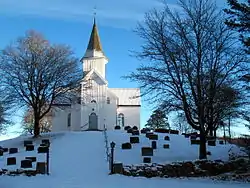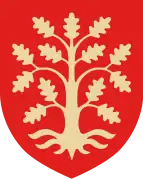Øvrebø (municipality)
Øvrebø is a former municipality that was located in the old Vest-Agder county in Norway. The municipality existed twice during the 19th and 20th centuries. Originally, from 1838 until 1865, the 398-square-kilometre (154 sq mi) municipality encompassed roughly the same boundaries as the present-day municipality of Vennesla. The second iteration of the municipality was only 109 square kilometres (42 sq mi) and it corresponded to the central part of present-day Vennesla municipality. The municipal centre was the village of Skarpengland. The small village of Øvrebø is located about 3 kilometres (1.9 mi) west of Skarpengland, and this is where the Øvrebø Church is located.[1]
Øvrebø herred | |
|---|---|
 View of the local Øvrebø Church | |
 Vest-Agder within Norway | |
 Øvrebø within Vest-Agder | |
| Coordinates: 58°17′29″N 07°46′42″E | |
| Country | Norway |
| County | Vest-Agder |
| District | Sørlandet |
| Established | 1838-1865 |
| Re-established | 1 July 1896 |
| Disestablished | 1 Jan 1964 |
| Administrative centre | Skarpengland |
| Area | |
| • Total | 109 km2 (42 sq mi) |
| *Area at municipal dissolution. | |
| Population (1964) | |
| • Total | 964 |
| • Density | 8.8/km2 (23/sq mi) |
| Time zone | UTC+01:00 (CET) |
| • Summer (DST) | UTC+02:00 (CEST) |
| ISO 3166 code | NO-1016 |
| Created as | Formannskapsdistrikt in 1838 |
| Succeeded by | Øvrebø og Hægeland and Vennesla in 1865 |
| Preceded by | Øvrebø og Hægeland in 1896 |
| Succeeded by | Vennesla in 1964 |
History
The parish of Øvrebø was established as a municipality on 1 January 1838 (see formannskapsdistrikt law). It existed as a municipality until 1865, when it was dissolved and split into two: the southeastern part of the municipality (population: 1,103) became the new municipality of Vennesla and the remainder of the municipality became Øvrebø og Hægeland (population: 1,829). On 1 July 1896 the municipality of Øvrebø was re-created when the municipality of Øvrebø og Hægeland was divided into two separate municipalities: Øvrebø (population: 888) and Hægeland (population: 843).
During the 1960s, there were many municipal mergers across Norway due to the work of the Schei Committee. On 1 January 1964, the Eikeland area (population: 39) of Øvrebø was transferred to neighboring Songdalen municipality, while the rest of Øvrebø (population: 925) was merged with Hægeland and Vennesla to form a new, larger municipality of Vennesla.[2]
Name
Øvrebø municipality was named after the old Øvrebø farm (Old Norse: Øfribœr), since the first Øvrebø Church was built there. The first part of the name means "upper" and second part of the name is identical with the word bœr which means "farm" and it is cognate with the Dutch language word "boer" which means "farmer". The name therefore means "the upper farm".[3]
Government
All municipalities in Norway, including Øvrebø, are responsible for primary education (through 10th grade), outpatient health services, senior citizen services, unemployment and other social services, zoning, economic development, and municipal roads. The municipality was governed by a municipal council of elected representatives, which in turn elected a mayor.[4]
Municipal council
The municipal council (Herredsstyre) of Øvrebø was made up of representatives that were elected to four year terms. The party breakdown of the final municipal council was as follows:
| Party Name (in Norwegian) | Number of representatives | |
|---|---|---|
| Labour Party (Arbeiderpartiet) | 2 | |
| Christian Democratic Party (Kristelig Folkeparti) | 3 | |
| Centre Party (Senterpartiet) | 6 | |
| Liberal Party (Venstre) | 2 | |
| Total number of members: | 13 | |
| Party Name (in Norwegian) | Number of representatives | |
|---|---|---|
| Labour Party (Arbeiderpartiet) | 2 | |
| Christian Democratic Party (Kristelig Folkeparti) | 3 | |
| Joint List(s) of Non-Socialist Parties (Borgerlige Felleslister) | 8 | |
| Total number of members: | 13 | |
| Party Name (in Norwegian) | Number of representatives | |
|---|---|---|
| Labour Party (Arbeiderpartiet) | 2 | |
| Joint List(s) of Non-Socialist Parties (Borgerlige Felleslister) | 10 | |
| Total number of members: | 12 | |
| Party Name (in Norwegian) | Number of representatives | |
|---|---|---|
| Labour Party (Arbeiderpartiet) | 2 | |
| Joint List(s) of Non-Socialist Parties (Borgerlige Felleslister) | 10 | |
| Total number of members: | 12 | |
| Party Name (in Norwegian) | Number of representatives | |
|---|---|---|
| Labour Party (Arbeiderpartiet) | 3 | |
| Joint List(s) of Non-Socialist Parties (Borgerlige Felleslister) | 9 | |
| Total number of members: | 12 | |
| Party Name (in Norwegian) | Number of representatives | |
|---|---|---|
| Labour Party (Arbeiderpartiet) | 2 | |
| Farmers' Party (Bondepartiet) | 6 | |
| Liberal Party (Venstre) | 4 | |
| Total number of members: | 12 | |
References
- Store norske leksikon. "Øvrebø – tidligere kommune" (in Norwegian). Retrieved 16 January 2017.
- Jukvam, Dag (1999). "Historisk oversikt over endringer i kommune- og fylkesinndelingen" (PDF) (in Norwegian). Statistisk sentralbyrå.
- Rygh, Oluf (1912). Norske gaardnavne: Lister og Mandals amt (in Norwegian) (9 ed.). Kristiania, Norge: W. C. Fabritius & sønners bogtrikkeri. p. 36.
- Hansen, Tore, ed. (12 May 2016). "kommunestyre". Store norske leksikon (in Norwegian). Kunnskapsforlaget. Retrieved 22 November 2020.
- "Kommunevalgene og Ordførervalgene 1959" (PDF) (in Norwegian). Oslo: Statistisk sentralbyrå. 1960. Retrieved 22 November 2020.
- "Kommunevalgene og Ordførervalgene 1955" (PDF) (in Norwegian). Oslo: Statistisk sentralbyrå. 1957. Retrieved 22 November 2020.
- "Kommunevalgene og Ordførervalgene 1951" (PDF) (in Norwegian). Oslo: Statistisk sentralbyrå. 1952. Retrieved 22 November 2020.
- "Kommunevalgene og Ordførervalgene 1947" (PDF) (in Norwegian). Oslo: Statistisk sentralbyrå. 1948. Retrieved 22 November 2020.
- "Kommunevalgene og Ordførervalgene 1945" (PDF) (in Norwegian). Oslo: Statistisk sentralbyrå. 1947. Retrieved 22 November 2020.
- "Kommunevalgene og Ordførervalgene 1937" (PDF) (in Norwegian). Oslo: Statistisk sentralbyrå. 1938. Retrieved 22 November 2020.

